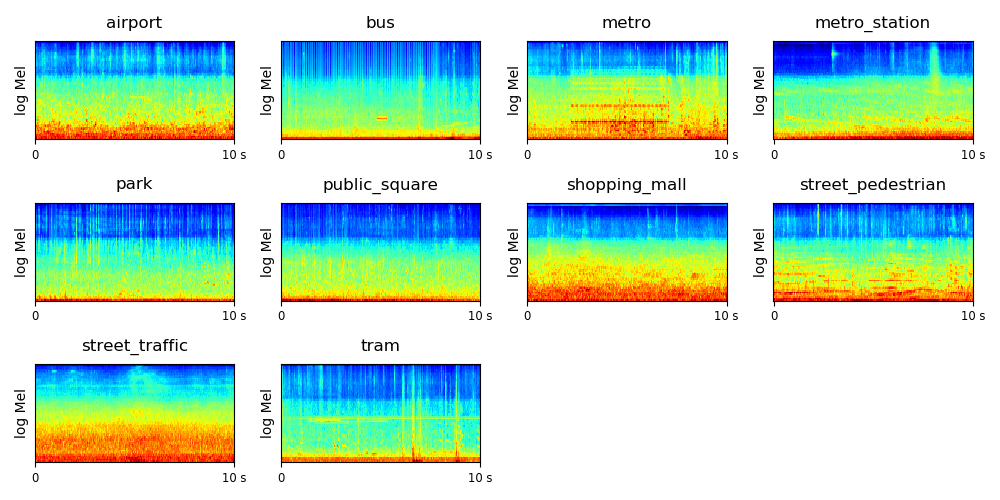DCASE 2018 Task 1 acoustic scene classification is a challenge to classifiy a 10 second audio clip to one of 10 classes such as 'airport', 'urban park', etc. We provide a convolutional neural network (CNN) baseline system implemented with PyTorch in this code base. More details about this challenge can be found http://dcase.community/challenge2018/task-acoustic-scene-classification
The dataset is downloadable from http://dcase.community/challenge2018/task-acoustic-scene-classification
The dataset contains 10 classes of audio scenes, recorded with Device A, B and C. The statistic of the data is shown below:
| Attributes | Dev. | Test | |
|---|---|---|---|
| Subtask A | Binanural, 48 kHz, 24 bit | Device A: 8640 | 1200 |
| Subtask B | Mono, 44.1 kHz | Device A: 8640 Device B: 720 Device C: 720 | 2400 |
| Subtask C | - | Any data | 1200 |
The log mel spectrogram of the scenes are shown below:
0. Prepare data. download and upzip data, the data looks like:
.
├── TUT-urban-acoustic-scenes-2018-development
│ ├── audio (8640 audios)
│ │ └── ...
│ ├── evaluation_setup
│ │ └── ...
│ ├── meta.csv
│ └── ...
├── TUT-urban-acoustic-scenes-2018-evaluation
│ ├── audio (3600 audios)
│ │ └── ...
│ ├── evaluation_setup
│ │ └── ...
│ ├── meta.csv
│ └── ...
├── TUT-urban-acoustic-scenes-2018-leaderboard
│ ├── audio (1200 audios)
│ │ └── ...
│ ├── evaluation_setup
│ │ └── ...
│ ├── meta.csv
│ └── ...
├── TUT-urban-acoustic-scenes-2018-mobile-development
│ ├── audio (10080 audios)
│ │ └── ...
│ ├── evaluation_setup
│ │ └── ...
│ ├── meta.csv
│ └── ...
├── TUT-urban-acoustic-scenes-2018-mobile-evaluation
│ ├── audio (15120 audios)
│ │ └── ...
│ ├── evaluation_setup
│ │ └── ...
│ ├── meta.csv
│ └── ...
└── TUT-urban-acoustic-scenes-2018-mobile-leaderboard
├── audio (2400 audios)
│ └── ...
├── evaluation_setup
│ └── ...
├── meta.csv
└── ...
1. (Optional) Install dependent packages. If you are using conda, simply run:
$ BACKEND="pytorch"
$ conda env create -f $BACKEND/environment.yml
$ conda activate py3_dcase2018_task1
(We developed this system with python 3. If you are using pytorch as backend then pytorch 0.4.0 is required.)
2. Then simply run:
$ ./runme.sh
Or run the commands in runme.sh line by line, including:
(1) Modify the paths of data and your workspace
(2) Extract features
(3) Train model
(4) Evaluation
The training looks like:
Loading data time: 19.000 s Split development data to 6122 training and 2518 validation data. Number of train audios in specific devices ['a']: 6122 tr_acc: 0.100, tr_loss: 6.437 Number of validate audios in specific devices ['a']: 2518 va_acc: 0.100, va_loss: 6.378 iteration: 0, train time: 0.118 s, validate time: 9.518 s ------------------------------------ Number of train audios in specific devices ['a']: 6122 tr_acc: 0.737, tr_loss: 0.709 Number of validate audios in specific devices ['a']: 2518 va_acc: 0.572, va_loss: 1.222 iteration: 100, train time: 21.682 s, validate time: 8.385 s ------------------------------------ ...... ------------------------------------ Number of train audios in specific devices ['a']: 6122 tr_acc: 1.000, tr_loss: 0.000 Number of validate audios in specific devices ['a']: 2518 va_acc: 0.680, va_loss: 1.347 iteration: 5000, train time: 23.928 s, validate time: 8.553 s ------------------------------------ ......
We use the provided training & validation split of the development data. We apply a convolutional neural network on the log mel spectrogram feature to solve this task. Training takes around 100 ms / iteration on a GTX Titan X GPU. The model is trained for 5000 iterations. The result is shown below.
Averaged accuracy over 10 classes:
| Device A | |
|---|---|
| averaged accuracy | 68.0% |
Confusion matrix:
Averaged accuracy over 10 classes of device A, B and C:
| Device A | Device B | Device C | |
|---|---|---|---|
| averaged accuracy | 67.9% | 61.7% | 57.2% |
Confusion matrix:
This codebase provides a convolutional neural network (CNN) for DCASE 2018 challenge Task 1.
"Kong, Qiuqiang, Turab Iqbal, Yong Xu, Wenwu Wang, and Mark D. Plumbley. "DCASE 2018 Challenge baseline with convolutional neural networks." arXiv preprint arXiv:1808.00773 (2018)."
If you met running out of GPU memory error, then try reduce batch_size.
The official baseline system implemented using Keras can be found https://github.com/DCASE-REPO/dcase2018_baseline




